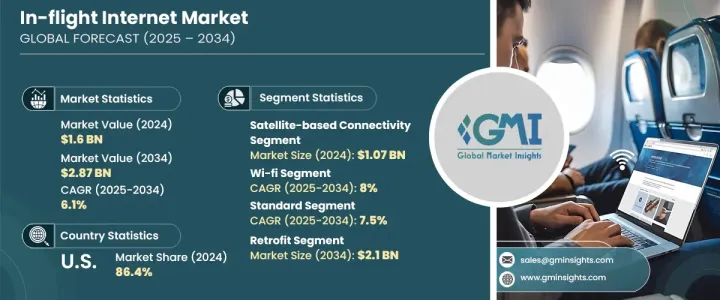
세계의 기내 인터넷 시장은 2024년에 16억 달러에 이르렀고, 2025년부터 2034년까지 연평균 복합 성장률(CAGR) 6.1%를 나타낼 것으로 예측됩니다.
승객들 사이에서 원활한 인터넷 연결에 대한 수요가 높아지고 있으며 위성 기술의 발전이 시장 성장을 가속하는 주요 요인이 되고 있습니다. 태블릿, 노트북의 보급은 여행자가 순항 고도에서도 연결을 유지할 것으로 기대하기 때문에 기내 연결의 필요성을 더욱 높여 왔습니다.

위성 기술의 진보와 위성 발사 횟수 증가는 기내 인터넷 시장을 대폭 강화하고 있습니다. 성능이 향상되어 항공사는 승객에게 충실한 서비스를 제공할 수 있게 되었습니다.
| 시장 범위 | |
|---|---|
| 시작 연도 | 2024년 |
| 예측 연도 | 2025-2034년 |
| 시작 금액 | 16억 달러 |
| 예측 금액 | 28억 7,000만 달러 |
| CAGR | 6.1% |
위성 기반 연결성이 2024년에 가장 큰 점유율을 차지해 10억 7,000만 달러의 수익을 올렸습니다. 위성 기반 인터넷은 일관된 연결성을 유지하기 위한 유일한 실행 가능한 솔루션으로 지속되고 있으며, Wi-Fi 영역은 비행 중 지속적인 연결에 대한 수요 증가에 힘입어 예측 기간 동안 CAGR 8%를 나타내 가장 빠르게 성장할 것으로 전망됩니다. 표준 연결 속도도 인기를 끌고 있으며 CAGR 7.5%를 나타낼 것으로 예상됩니다.
개장 분야는 첨단 연결 솔루션을 통한 항공기 현대화로 2034년까지 21억 달러 규모에 도달할 것으로 예측됩니다. 무료 Wi-Fi 분야는 2024년에 58.1%의 점유율을 차지했으며 항공사가 승객의 유치와 유지를 위해 무료 인터넷 서비스를 제공하는 경향이 강해지고 있기 때문에 예측 기간을 통해 우위를 유지할 것으로 예측됩니다.
상업용 분야는 2024년에 시장 점유율의 84.6%를 차지했지만, 이는 여객 체험의 향상에 있어서의 접속성의 중요성이 높아지고 있는 것이 배경에 있습니다. 미국 시장은 2024년 86.4%의 점유율로 북미 시장을 주도했습니다. 이 나라에는 대규모 항공시장이 있으며, 대규모 인터넷 서비스 제공업체와 위성 제조업체가 존재하는 것이 이 시장의 우위성에 기여하고 있어 향후에도 성장이 예상됩니다.
KTHThe Global In-Flight Internet Market reached USD 1.6 billion in 2024 and is expected to grow at a CAGR of 6.1% from 2025 to 2034. The rising demand for seamless internet connectivity among passengers and advancements in satellite technology are major factors driving market growth. As global air travel returns to pre-pandemic levels, passengers increasingly seek internet access during flights for entertainment, communication, and work. The widespread use of smartphones, tablets, and laptops further intensifies the need for in-flight connectivity, as travelers expect to stay connected even at cruising altitudes. This growing demand places airlines under pressure to enhance passenger satisfaction and maintain a competitive edge by offering reliable internet services.

Advances in satellite technology and an increasing number of satellite launches have significantly bolstered the in-flight internet market. These innovations enable faster data transmission and broader coverage, providing reliable connectivity even over remote areas and oceans. The introduction of modern satellites has improved internet speed and performance, allowing airlines to offer enhanced services to passengers. With in-flight internet becoming a necessity rather than a luxury, airline operators are collaborating with internet service providers to integrate advanced connectivity solutions and stay ahead in the market.
| Market Scope | |
|---|---|
| Start Year | 2024 |
| Forecast Year | 2025-2034 |
| Start Value | $1.6 Billion |
| Forecast Value | $2.87 Billion |
| CAGR | 6.1% |
Satellite-based connectivity held the largest share in 2024, generating USD 1.07 billion in revenue. The growth in satellite launches and technological advancements in satellite communication are driving this segment. As most flights travel over remote areas, satellite-based internet remains the only viable solution for maintaining consistent connectivity. The Wi-Fi segment is growing at the fastest CAGR of 8% during the forecast period, fueled by the increasing demand for continuous connectivity during flights. Standard connectivity speed is also gaining traction, growing at a CAGR of 7.5%, as many passengers require internet access for basic tasks such as emailing, messaging, and browsing.
The retrofit segment is projected to reach a market size of USD 2.1 billion by 2034, driven by the modernization of aircraft fleets with advanced connectivity solutions. Retrofitting upgrades existing aircraft with state-of-the-art internet systems, eliminating the need to invest in new planes. The free Wi-Fi segment held a 58.1% share in 2024 and is expected to maintain dominance throughout the forecast period as airlines increasingly offer complimentary internet services to attract and retain passengers.
The commercial segment accounted for 84.6% of the market share in 2024, driven by the growing importance of connectivity in enhancing passenger experiences. The U.S. market led in North America, with an 86.4% share in 2024. The country's large aviation market and the presence of leading internet service providers and satellite manufacturers contribute to its dominance, ensuring continued growth in the years ahead.